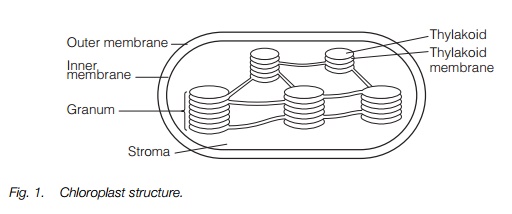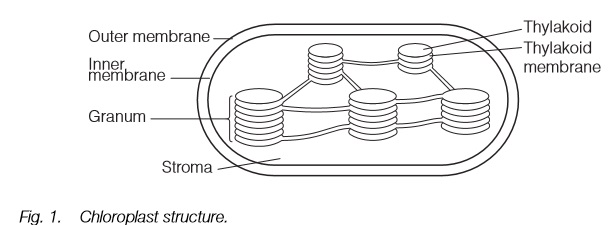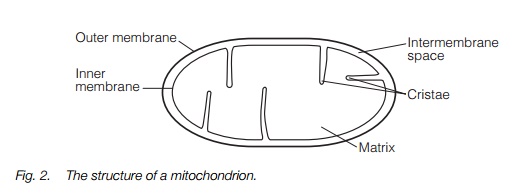Chapter: Plant Biology : Structure
Structure of Plant cell Plastids and mitochondria

PLASTIDS AND MITOCHONDRIA
Key Notes
Plastids
Plastids are a family of organelles bounded by two external membranes. Family members include: photosynthetic chloroplasts; chromoplasts containing pigments; leucoplasts involved in lipid biosynthesis; amyloplasts that store starch; and etioplasts, an intermediate stage in production of chloroplasts.
Chloroplast structure and origins
Plastids contain a small genome encoding some plastid proteins. Many other chloroplast proteins are encoded by nuclear genes. The endosymbiont theory suggests that they arose as primitive photosynthetic organisms that colonized cells. Stacks of thylakoid membranes (grana) containing chlorophyll are present in the matrix space (stroma).
Mitochondria
Mitochondria are the site of synthesis of adenosine triphosphate (ATP) using lipids, carbohydrates and other high energy compounds as fuel.
Mitochondrial structure
Mitochondria are bounded by an outer membrane with an inner fluidfilled stroma (matrix). An inner, selectively permeable membrane, folded into cristae, contains the components necessary for ATP-synthesis. Mitochondria contain a small genome that encodes some, but not all, mitochondrial proteins.
Plastids are characteristic of plant cells and otherwise only occur in plant-like protists. They are organelles bounded by a double membrane. There are several types of plastid in plant cells. Chloroplasts are photosynthetic plastids found in the mesophyll cells of leaves, the cortex of herbaceous stems and in small numbers elsewhere in the plant. The green coloration is due to the presence of the pigment chlorophyll (Topic J1).
Chromoplasts contain pigments other than chlorophyll and are associated with brightly colored structures like ripe fruit. Leucoplastsare colorless and are found in many cell types. They include amyloplasts that store starch and elaioplasts that synthesize lipid.Etioplasts are an intermediate stage in the production of photosynthetic chloroplasts in tissue exposed to light for the first time.
Chloroplast structure and origins
The two membranes of plastids surround a central fluid-filled stroma (Fig. 1). Plastids contain their own DNA in a small ‘plastid genome’ containing genes for some chloroplast proteins. This, together with the presence of the double outer

membrane, has led to suggestions that they arose as endosymbionts – primitive photosynthetic organisms that colonized a non-photosynthetic cell. However, while some chloroplast proteins are synthesized on plastid ribosomes, from genes in the chloroplast genome, many others are encoded by nuclear genes and imported. Chloroplasts are highly organized for photosynthesis. Suspended in the stroma are thylakoids, membrane discs that form stacks or grana. Individual stacks are interconnected by tubes of thylakoid membrane. The photosynthetic pigments are arranged in the stacks so that they can be orientated to capture as much light energy as possible. For details of the mechanism of photosynthesis see Topics J1 and J2.
Mitochondria
Mitochondria convert the energy in storage reserves, like lipid, starch and other carbohydrates, into the high energy compoundadenosine triphosphate (ATP). The mitochondrion (Fig. 2) provides an isolated environment in which high energy intermediates can be formed without reactions with other cell constituents. Mitochondria contain a small mitochondrial genome, a circular piece of DNA encoding some (but not all) mitochondrial proteins, which are synthesized on mitochondrial ribosomes. Other proteins are encoded by nuclear DNA and synthesized on cytoplasmic ribosomes. Mitochondria can divide to give further mitochondria and can fuse to form an interconnected tubular mesh. Mitochondria are present in all cells and are abundant in those with high energy demands like phloem companion cells (Topic C3).
Mitochondrial structure
Mitochondria are bounded by two outer membranes. The inner of these membranes is invaginated (folded) to form cristae (singularcrista) which project into the inner space, the stroma or matrix. This inner mitochondrial membrane therefore separates two compartments: the intermembrane space and the matrix space. It is selectively permeable and contains the transportproteins involved in ATP production .
